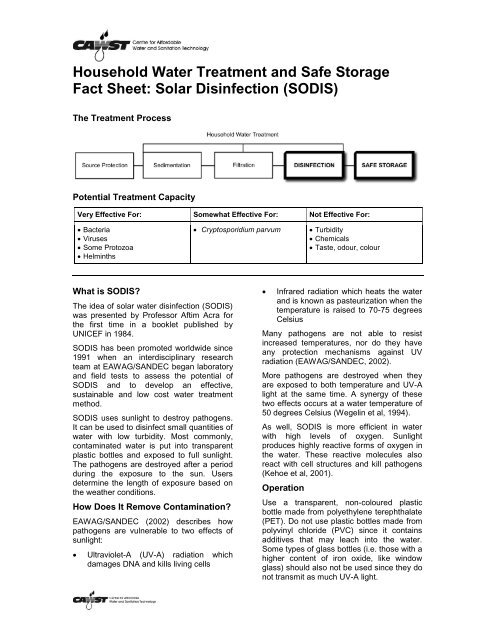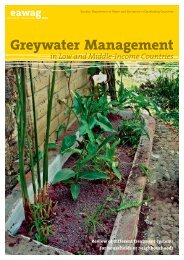Household Water Treatment and Safe Storage Factsheet: Source ...
Household Water Treatment and Safe Storage Factsheet: Source ...
Household Water Treatment and Safe Storage Factsheet: Source ...
You also want an ePaper? Increase the reach of your titles
YUMPU automatically turns print PDFs into web optimized ePapers that Google loves.
<strong>Household</strong> <strong>Water</strong> <strong>Treatment</strong> <strong>and</strong> <strong>Safe</strong> <strong>Storage</strong><br />
Fact Sheet: Solar Disinfection (SODIS)<br />
The <strong>Treatment</strong> Process<br />
Potential <strong>Treatment</strong> Capacity<br />
Very Effective For: Somewhat Effective For: Not Effective For:<br />
Bacteria<br />
Viruses<br />
Some Protozoa<br />
Helminths<br />
Cryptosporidium parvum<br />
Turbidity<br />
Chemicals<br />
Taste, odour, colour<br />
What is SODIS?<br />
The idea of solar water disinfection (SODIS)<br />
was presented by Professor Aftim Acra for<br />
the first time in a booklet published by<br />
UNICEF in 1984.<br />
SODIS has been promoted worldwide since<br />
1991 when an interdisciplinary research<br />
team at EAWAG/SANDEC began laboratory<br />
<strong>and</strong> field tests to assess the potential of<br />
SODIS <strong>and</strong> to develop an effective,<br />
sustainable <strong>and</strong> low cost water treatment<br />
method.<br />
SODIS uses sunlight to destroy pathogens.<br />
It can be used to disinfect small quantities of<br />
water with low turbidity. Most commonly,<br />
contaminated water is put into transparent<br />
plastic bottles <strong>and</strong> exposed to full sunlight.<br />
The pathogens are destroyed after a period<br />
during the exposure to the sun. Users<br />
determine the length of exposure based on<br />
the weather conditions.<br />
How Does It Remove Contamination?<br />
EAWAG/SANDEC (2002) describes how<br />
pathogens are vulnerable to two effects of<br />
sunlight:<br />
Ultraviolet-A (UV-A) radiation which<br />
damages DNA <strong>and</strong> kills living cells<br />
<br />
Infrared radiation which heats the water<br />
<strong>and</strong> is known as pasteurization when the<br />
temperature is raised to 70-75 degrees<br />
Celsius<br />
Many pathogens are not able to resist<br />
increased temperatures, nor do they have<br />
any protection mechanisms against UV<br />
radiation (EAWAG/SANDEC, 2002).<br />
More pathogens are destroyed when they<br />
are exposed to both temperature <strong>and</strong> UV-A<br />
light at the same time. A synergy of these<br />
two effects occurs at a water temperature of<br />
50 degrees Celsius (Wegelin et al, 1994).<br />
As well, SODIS is more efficient in water<br />
with high levels of oxygen. Sunlight<br />
produces highly reactive forms of oxygen in<br />
the water. These reactive molecules also<br />
react with cell structures <strong>and</strong> kill pathogens<br />
(Kehoe et al, 2001).<br />
Operation<br />
Use a transparent, non-coloured plastic<br />
bottle made from polyethylene terephthalate<br />
(PET). Do not use plastic bottles made from<br />
polyvinyl chloride (PVC) since it contains<br />
additives that may leach into the water.<br />
Some types of glass bottles (i.e. those with a<br />
higher content of iron oxide, like window<br />
glass) should also not be used since they do<br />
not transmit as much UV-A light.
















